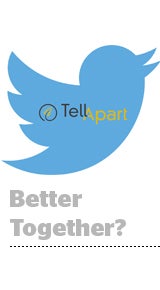 Twitter is taking cross-device retargeting under its wing with the acquisition of digital ad platform TellApart.
Twitter is taking cross-device retargeting under its wing with the acquisition of digital ad platform TellApart.
“Direct response advertising has been a major growth engine for our ads business over the last several quarters. … TellApart will accelerate that trajectory further,” said Kevin Weill, Twitter’s SVP of product, in a blog post Tuesday.
According to Twitter CEO Dick Costolo, TellApart brings three core benefits: cross-device identity, targeting and attribution. Twitter is looking to close the deal by June 1.
TellApart’s acquisition, the price of which was not disclosed, came amid a disastrous earnings leak followed by a precipitous drop in the company’s stock price Tuesday – it closed at about 18% lower than where it started. Research company Selerity released the results before market close, resulting in a loss of around $7 billion in value. In remarks on its earnings call with investors, Twitter management appeared to blame Nasdaq for the screw-up. [Earnings release.]
Updated, 4/30/15: A securities filing made public on Wednesday revealed that Twitter agreed to pay $532.6 million in stock for TellApart, in other words 12.6 million shares at $42.27, which was Twitter’s closing price on April 28.
Twitter turned in a middling quarter with Q1 revenue of $436 million, a rise of 74% year over year and below the company’s guidance of $440 million to $450 million. The company reported a net loss of $162 million.
Data licensing and “other revenue” accounted for $48 million in Q1, according to Twitter CFO Anthony Noto. Twitter also broke out its ad revenue, citing a 72% YoY increase to $388 million, of which US ad revenue accounted for 59%. Mobile ad revenue clocked in at 89% of the $388 million.
The stagnancy of Twitter’s monthly active user growth has been a particular concern for investors for the last several quarters, which its Q1 numbers didn’t do much to assuage. Average monthly active users (MAUs) rose 18% year over year to 302 million. Average mobile MAUs were 80% of total MAUs.
A somewhat harried Costolo noted during the Q1 call that Twitter would consider running a marketing campaign to promote its own products – the new homepage aimed at logged out users and instant timelines, for example – when they’re “at a place where we really feel good about the kind of experience we’re dropping people into the moment they come to Twitter. … I think we’re a lot closer to that now.”
Tell Me About It
TellApart, which bills itself as a retail-focused ad platform, has gained a position in the marketing partner programs for both Facebook and Twitter. The company built a name for itself in advanced retargeting use cases and DR solutions for the likes of Neiman Marcus, Sur la Table, Wayfair and Pottery Barn.
Noto told investors that TellApart’s third-party publisher inventory will be migrated on its platform “over time,” which means it might take some time for the acquisition to impact Twitter’s bottom line.
At AdExchanger’s Industry Preview event in January, LUMA Partners lead Brian Andersen noted that TellApart represents a sort of hybrid between commerce technology and web analytics.
The predictive nature of TellApart’s tech is particularly interesting for a player like Twitter, which appears to be looking beyond paid channels and its own limited scale to make itself more attractive to advertisers. Marketing, as opposed to paid advertising, is arguably an opportunity for Twitter, which could carve out a place for itself in the commerce space.
To that end, Twitter finally delivered on a buy button in recent weeks, bringing long-promised commerce to the tweet. Sports ticket sellers like the Atlanta Hawks have been among the first to take advantage.
For its part, Twitter is positioning the TellApart acquisition as a way for it to provide a better service for its performance advertisers, reaching consumers as they move between devices. Although its reach is smaller than other deterministic data players in the space, most notably Facebook, Twitter certainly has an opportunity around its logged-in user data.
“One of the biggest challenges facing marketers today is the fractured nature of the consumer experience – across devices, between the web and apps, and between the digital and the physical worlds,” wrote TellApart CEO Josh McFarland on his company’s site. “While there are no silver bullets to solve this problem for advertisers, we believe that by working together with Twitter we can considerably improve the experience.”
TellApart’s technology could help Twitter siphon more marketing spend through its platform across devices, which might do something to redirect investor attention away from Twitter’s less-than-stellar MAU situation.
Twitter could also use a little help in the direct response department. Several of Twitter’s DR products, lead gen cards, for example, “fell short of expectations in Q1,” which didn’t help with overall revenue numbers. But Noto put a positive spin on the decline, attributing the dip to Twitter’s “raising of the bar” in terms of what constitutes engagement and its focus on “delivering users further down the funnel.” [In that vein, Twitter nixed Timeline view as a measure of engagement on Monday.]
“Today, this results in a lower click-through rate and less revenue for Twitter,” Noto said. “However, long term, we expect that the higher ROI that advertisers are getting … will more than offset the lower click-through rate.”
The TellApart acquisition and earnings woes weren’t the only news to come out of Twitter on Tuesday. The company also announced that it would partner with Google to allow advertisers on Twitter to use DoubleClick to measure when a conversion comes as the result of views or other actions on the Twitter platform.
And, Twitter announced inventory in the form of promoted tweets will also be available through DoubleClick Bid Manager. Read AdExchanger’s related story, “Coming Soon To Google’s DoubleClick Bid Manager: Promoted Tweets.”














